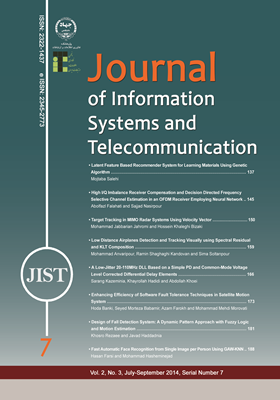High I/Q Imbalance Receiver Compensation and Decision Directed Frequency Selective Channel Estimation in an OFDM Receiver Employing Neural Network
محورهای موضوعی : Signal Processingابوالفضل فلاحتی 1 , Sajjad Nasirpour 2
1 -
2 - Iran University of Science and Technology
کلید واژه: I/Q Imbalance, OFDM, Zero-IF, Direct Conversion, Neural Network, Channel Estimation, Frequency Selective Channel, ,
چکیده مقاله :
The disparity introduced between In-phase and Quadrature components in a digital communication system receiver known as I/Q imbalance is a prime objective within the employment of direct conversion architectures. It reduces the performance of channel estimation and causes to receive the data symbol with errors. This imbalance phenomenon, at its lowest still can result very serious signal distortions at the reception of an OFDM multi-carrier system. In this manuscript, an algorithm based on neural network scenario, is proposed that deploys both Long Training Symbols (LTS) as well as data symbols, to jointly estimate the channel and to compensate parameters that are damaged by I/Q imbalanced receiver. In this algorithm, we have a tradeoff between these parameters. I.e. when the minimum CG mean value is required, the minimum CG mean value could be chosen without others noticing it, but in usual case we have to take into account other parameters too, the limited values for the aimed parameters must be known. It uses the first iterations to train the system to reach the suitable value of GC without error floor. In this present article, it is assumed that the correlation between subcarriers is low and a few numbers of training and data symbols are used. The simulation results show that the proposed algorithm can compensate the high I/Q imbalance values and estimate channel frequency response more accurately compared with to date existing methods.
The disparity introduced between In-phase and Quadrature components in a digital communication system receiver known as I/Q imbalance is a prime objective within the employment of direct conversion architectures. It reduces the performance of channel estimation and causes to receive the data symbol with errors. This imbalance phenomenon, at its lowest still can result very serious signal distortions at the reception of an OFDM multi-carrier system. In this manuscript, an algorithm based on neural network scenario, is proposed that deploys both Long Training Symbols (LTS) as well as data symbols, to jointly estimate the channel and to compensate parameters that are damaged by I/Q imbalanced receiver. In this algorithm, we have a tradeoff between these parameters. I.e. when the minimum CG mean value is required, the minimum CG mean value could be chosen without others noticing it, but in usual case we have to take into account other parameters too, the limited values for the aimed parameters must be known. It uses the first iterations to train the system to reach the suitable value of GC without error floor. In this present article, it is assumed that the correlation between subcarriers is low and a few numbers of training and data symbols are used. The simulation results show that the proposed algorithm can compensate the high I/Q imbalance values and estimate channel frequency response more accurately compared with to date existing methods.


